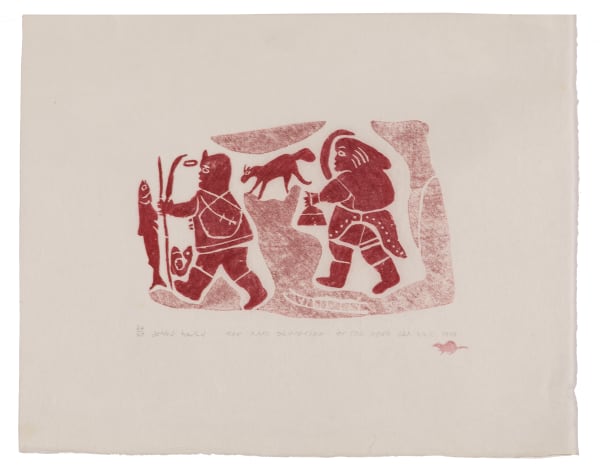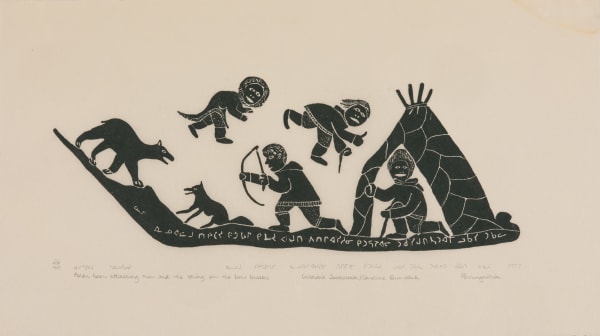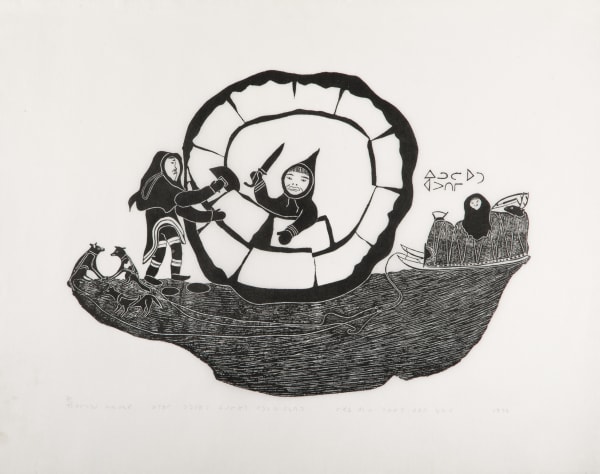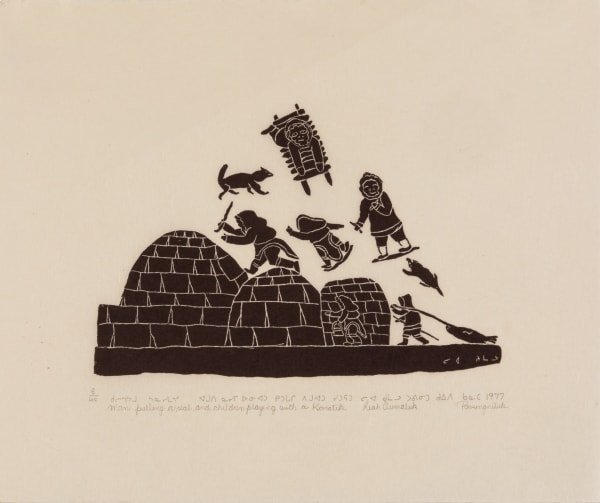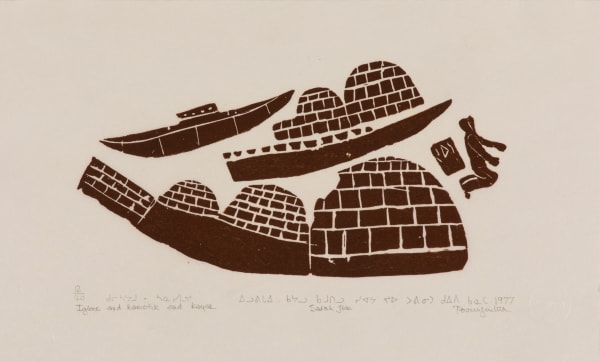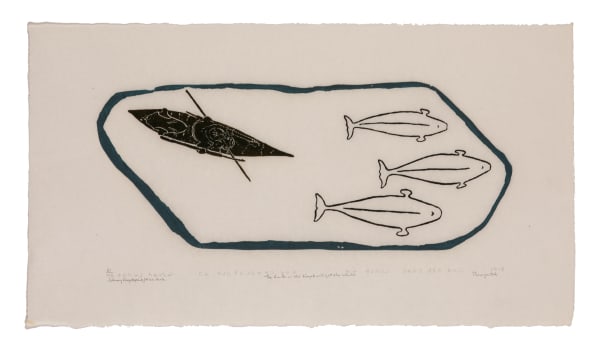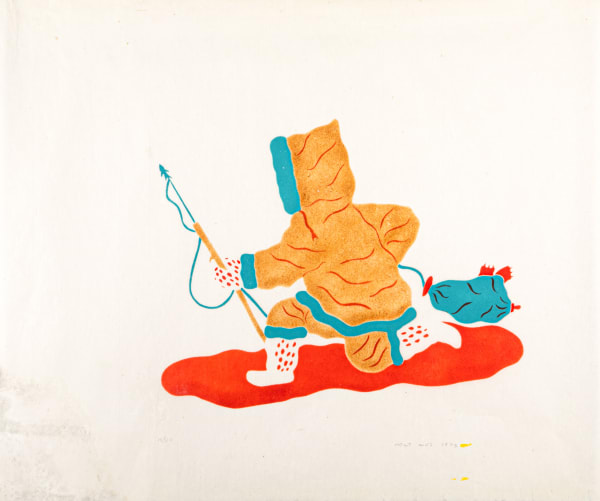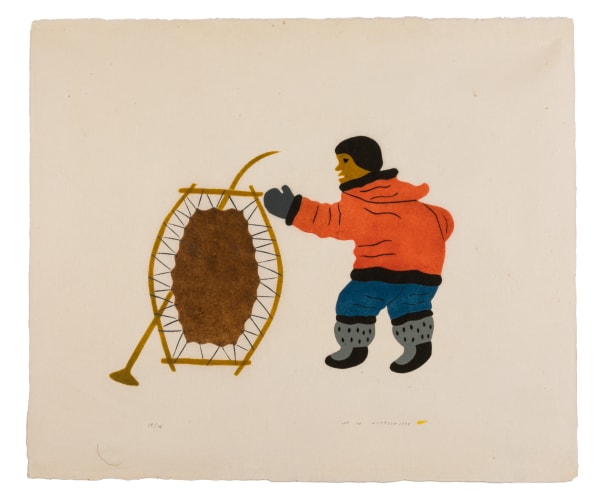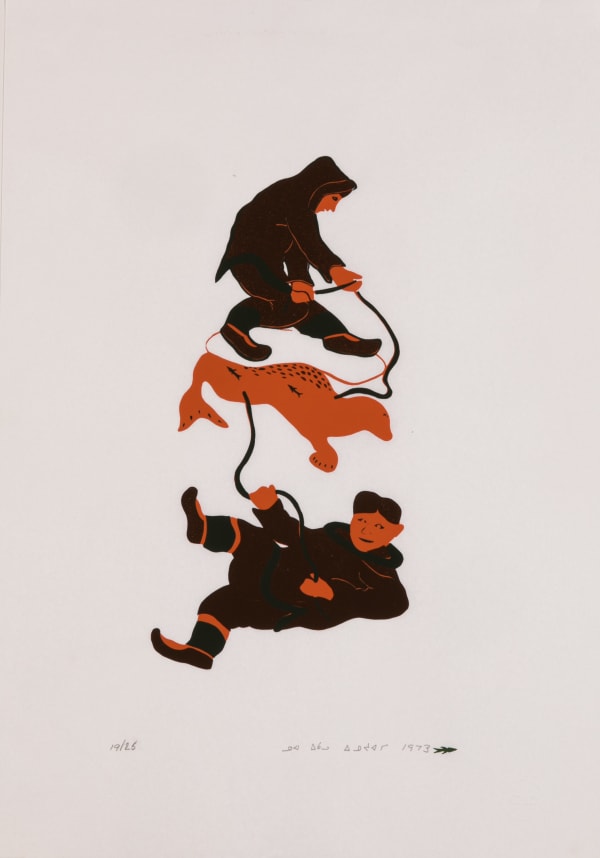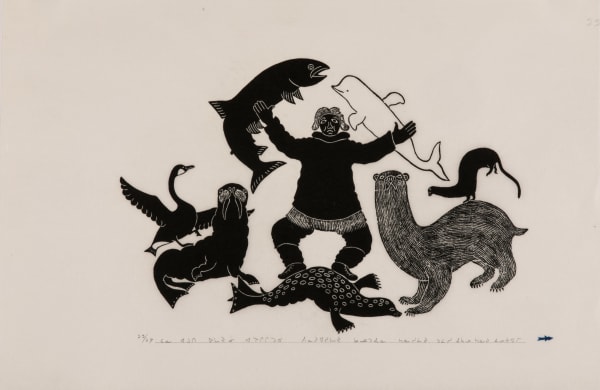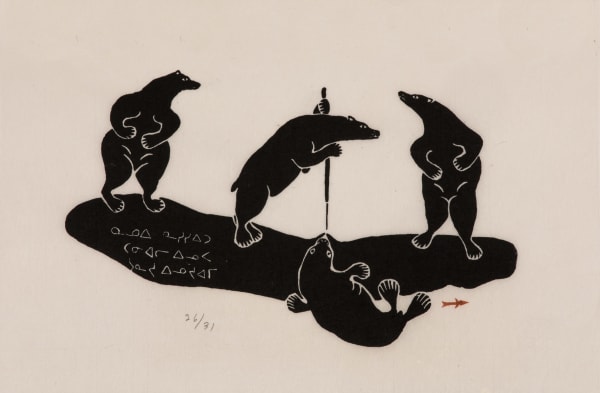Inspired by the inaugural Kinngait (Cape Dorset) print release in 1959 and the positive reception to the Cape Dorset prints in the South, numerous Arctic communities tried their hand at printmaking. While Kinngait and Qamani'tuaq (Baker Lake) prints are the better known today, spectacular prints have been created in Puvirnituq (Povungnituk), Ulukhaqtuuq (Holman Island), and Panniqtuuq (Pangnirtung), and elsewhere. It seems a shame that prints from these other communities live in the shadow of Kinngait, as it were. It is, therefore, our pleasure at First Arts to shine the spotlight on the delightful prints of Nunavik, thanks to a delightful group of works amassed by a single Montreal collector.
Puvirnituq Prints
The community of Puvirnituq (Povungnituk and sometimes simply referred to as POV) is located on the Povungnituk River near its mouth on the east coast of Hudson Bay in Nunavik. The name means “place where there is a smell of rotten meat.” This colourful name may originate from an event where a herd of caribou drowned while attempting a river crossing and the bodies washed ashore and decomposed, or alternatively from an epidemic that killed most of the population, leaving not enough survivors to bury the dead.
The Povungnituk Co-operative Society, incorporated in 1960, helped the local population transition from a fur trading economy to one fueled by the creation of artworks and handicrafts for sale in southern Canada. Encouraged by the success of the Cape Dorset prints, the Co-operative Society, with the assistance of the local priest Father André Steinmann, engaged the services of artist Gordon Yearsley to teach various printmaking techniques in 1961. These early experimental prints, strongly influenced by those produced in Kinngait, were not a success. The 1962 collection was created with the advice of another artist, Victor Tinkl. Tinkl taught stonecut techniques to local sculptors such as Davidialuk and Joe Talirunili, giving them great freedom in both the design and execution of their print images. The 1962 Povungnituk Collection was introduced to the public in the same exhibition (at the Montreal Museum of Fine Arts) and the same catalogue as the 1962 Dorset collection in the fall of 1963. From 1964 on, Puvirnituq annual print collections were marketed independently.
There are numerous features that set Puvirnituq stonecut prints apart from those of other Inuit communities. The most obvious visible characteristic of POV prints is the frequent use of the stone block itself as a visual element; often the entire stone, and not just the carved image, is fully inked and printed. The uneven shapes of print stones were employed very successfully for images by several Puvirnituq print artists such as Joe Talirunili, Juanisialu Irqumia, Leah Qumaluk, Levi Qumaluk, Josie Papialuk and others. Also notable is the fact that unlike at Cape Dorset, where a stonecutter or master printer generally interpreted an artist’s original drawing, many POV print artists (most of whom were also stone sculptors) would carve their images directly onto the stone blocks themselves, without the intermediate step of preparatory drawings. Another trait common to POV prints is that most, but not all, of the early images were monochromatic. These various features give many Puvirnituq images an air of immediacy, ruggedness, and folk-art charm.
One senses that despite ultimately producing art for a “southern” audience, Puvirnituq printmakers were, broadly speaking, more interested in documenting local myths, legends, personal narratives, and lifestyle than they were in catering to southern tastes—or indeed to the taste of the Canadian Eskimo Arts Council (which for decades oversaw the vetting of images sent down from Arctic communities.) Another distinguishing feature of POV prints is that they are almost exclusively annotated in Inuktitut rather than English. While an important affirmation of Inuit identity, this may have proved to be a setback in the southern art market as viewers were often unable to decipher the titles of the prints or even the names of the artists. The Puvirnituq print program eventually shuttered in 1989, but it left an extraordinary legacy of imagery for posterity.
Arctic Quebec Print Collections
La Fédération des Coopératives du Nouveau-Québec sponsored a six-week printmaking course in Puvirnituq in April-May 1972. Eighteen artists from across the Nunavik Region were taught stonecut and stencil printmaking techniques by visiting artist Robert Paterson. A total of six print collections were released under the “Arctic Quebec” banner beginning in late 1972, followed by two collections each in 1973 and 1974, with a final collection in 1975. This exhibition includes ten images from the 1973 II catalogue which featured forty prints from Kuujjuaraapik (Great Whale River), Ivujivik, and Inukjuak (Port Harrison). Catalogues featuring prints by single artists—Tivi Etok and Peter Morgan, both from Kangiqsualujjuak (George River)—were released between 1975 and 1978, but sadly the production of Nunavik prints outside of Puvirnituq did not continue after that.
We are now appointments to view the works in this exhibition anytime between Monday and Friday 10:00 AM - 4:00 PM at A.H. Wilkens Auctions & Appraisals, One William Morgan Drive, East York, ON.
If you are unable to attend our previews in person, our team can provide thorough and comprehensive condition reports and additional images and videos. We welcome your enquiries at info@firstarts.ca or 647-286-5012.
Works in this exhibition are subject to prior sale.
-
-
 JOE TALIRUNILI (1893-1976) PUVIRNITUQ (POVUNGNITUK)
JOE TALIRUNILI (1893-1976) PUVIRNITUQ (POVUNGNITUK)The Ancient Way of Hunting, 1977 #41
stonecut, 19 x 27.5 in (48.3 x 69.8 cm)
-
 DAVIDIALUK ALASUA AMITTU (1910-1976) PUVIRNITUQ (POVUNGNITUK)
DAVIDIALUK ALASUA AMITTU (1910-1976) PUVIRNITUQ (POVUNGNITUK)Legend of the Giant, 1978 #47
stonecut, 24.5 x 34 in (62.5 x 86.3 cm)
-
 DAVIDIALUK ALASUA AMITTU (1910-1976) PUVIRNITUQ (POVUNGNITUK)
DAVIDIALUK ALASUA AMITTU (1910-1976) PUVIRNITUQ (POVUNGNITUK)Inuit in Their Land in Winter, 1977 #27
stonecut, 15.5 x 25.75 in (39.4 x 65.4 cm)
-
 SYOLLIE AMITUK (1936-1986) PUVIRNITUQ (POVUNGNITUK)
SYOLLIE AMITUK (1936-1986) PUVIRNITUQ (POVUNGNITUK)Eskimo Village in Winter, 1973 #18
stonecut and stencil, 25 x 36.75 in (63.5 x 93.3 cm
-
 SYOLLIE AMITUK (1936-1986) PUVIRNITUQ (POVUNGNITUK)
SYOLLIE AMITUK (1936-1986) PUVIRNITUQ (POVUNGNITUK)Hawk Frightens Feeding Geese, 1972 #23
stonecut, 30 x 24.25 in (76.2 x 61.6 cm)
-
 PETER ASSAPA (1958-) PUVIRNITUQ (POVUNGNITUK)
PETER ASSAPA (1958-) PUVIRNITUQ (POVUNGNITUK)A Man and His Wife Getting Ready for a Dog Team Trip, 1973 #23
stonecut, 24.25 x 32 in (61.6 x 81.3 cm)
-
 JOSIE PAMIUTU PAPIALUK (1918-1996) PUVIRNITUQ (POVUNGNITUK)
JOSIE PAMIUTU PAPIALUK (1918-1996) PUVIRNITUQ (POVUNGNITUK)Man Hunting Birds Who Fly Away, 1977 #40
stonecut, 16.25 x 28.75 in (41.3 x 73 cm)
-
 SYOLLIE AMITUK (1936-1986) PUVIRNITUQ (POVUNGNITUK)
SYOLLIE AMITUK (1936-1986) PUVIRNITUQ (POVUNGNITUK)Snow Goose Shaking its Feathers, 1973 #19
stonecut, 31.25 x 24.25 in (79.4 x 61.6 cm)
-
 JOSIE PAMIUTU PAPIALUK (1918-1996) PUVIRNITUQ (POVUNGNITUK)
JOSIE PAMIUTU PAPIALUK (1918-1996) PUVIRNITUQ (POVUNGNITUK)Man Standing with Raised Arms and Wearing Eider Clothes, 1977 #38
stonecut, 17.25 x 22 in (43.8 x 55.9 cm)
-
 JOSIE PAMIUTU PAPIALUK (1918-1996) PUVIRNITUQ (POVUNGNITUK)
JOSIE PAMIUTU PAPIALUK (1918-1996) PUVIRNITUQ (POVUNGNITUK)Man with a Harpoon in his Hand, 1977 #35
stonecut, 15.5 x 18.75 in (39.4 x 47.6 cm)
-
 ANNIE MIKPIGAK (1900-1984) PUVIRNITUQ (POVUNGNITUK)
ANNIE MIKPIGAK (1900-1984) PUVIRNITUQ (POVUNGNITUK)A Long Time Ago Inuit Used To Hunt by Walking, 1973 #10
stonecut, 14 x 18 in (35.6 x 45.7 cm)
-
 JUANISIALU IRQUMIA (1912-1977) PUVIRNITUQ (POVUNGNITUK)
JUANISIALU IRQUMIA (1912-1977) PUVIRNITUQ (POVUNGNITUK)Preparing a Sealskin to Dry, 1977 #1
stonecut, 17.5 x 21.25 in (44.5 x 54 cm)
-
 CAROLINE QUMALUK (1913-D) PUVIRNITUQ (POVUNGNITUK)
CAROLINE QUMALUK (1913-D) PUVIRNITUQ (POVUNGNITUK)Polar Bear Attacking men and the String on the Bow Breaks, 1977 #19
stonecut, 14 x 26.5 in (35.6 x 67.3 cm)
-
 LUCASSIE TOOKALOOK (1917-D?) PUVIRNITUQ (POVUNGNITUK)
LUCASSIE TOOKALOOK (1917-D?) PUVIRNITUQ (POVUNGNITUK)People from Long ago Walking and Hunting Caribou, 1977 #22
stonecut, 16.75 x 22.5 in (42.5 x 57.1 cm)
-
 LUCASSIE TOOKALOOK (1917-D?) PUVIRNITUQ (POVUNGNITUK)
LUCASSIE TOOKALOOK (1917-D?) PUVIRNITUQ (POVUNGNITUK)Legend-Lumak has been carried away by the Whale and has been living for many years, 1977 #24
stonecut, 15.25 x 24.75 in (38.7 x 62.9 cm)
-
 ISAH PAPIALUK (1926-) PUVIRNITUQ (POVUNGNITUK)
ISAH PAPIALUK (1926-) PUVIRNITUQ (POVUNGNITUK)During the Winter, They Harpoon the Walrus at the Breathing Hole, 1978 #16
stonecut, 16 x 18.75 3/4 in (40.3 x 47.5 cm)
-
 SYOLLIE AMITUK (1936-1986) PUVIRNITUQ (POVUNGNITUK)
SYOLLIE AMITUK (1936-1986) PUVIRNITUQ (POVUNGNITUK)Man Hunting in Summer by Kayak, 1977 #15
stonecut, 19.75 x 28 in (50.2 x 71.1 cm)
-
 JOSIE UNARLUK (1926-D) PUVIRNITUQ (POVUNGNITUK)
JOSIE UNARLUK (1926-D) PUVIRNITUQ (POVUNGNITUK)Seal Hunting in Winter, Also a Kayak, 1978 #14
stonecut, 14 x 17.25 in (35.5 x 44 cm)
-
 PETER ASSAPA (1958-) PUVIRNITUQ (POVUNGNITUK)
PETER ASSAPA (1958-) PUVIRNITUQ (POVUNGNITUK)Inuit Used To Move Places Dragging Their Sleds, 1973 #24
stonecut, 23.25 x 27.25 in (59.1 x 69.2 cm)
-
 PAULOSIE SIVUAK (1930-1986) PUVIRNITUQ (POVUNGNITUK)
PAULOSIE SIVUAK (1930-1986) PUVIRNITUQ (POVUNGNITUK)A Woman Fishing in Winter, 1978 #23
stonecut, 20 x 18.25 in (51 x 46.5 cm)
-
 LEVI QUMALUK (1919-1997) PUVIRNITUQ (POVUNGNITUK)
LEVI QUMALUK (1919-1997) PUVIRNITUQ (POVUNGNITUK)Building The Igloo, 1972 #26
stonecut, 24.5 x 31 in (62.2 x 78.7 cm)
-
 LEVI QUMALUK (1919-1997) PUVIRNITUQ (POVUNGNITUK)
LEVI QUMALUK (1919-1997) PUVIRNITUQ (POVUNGNITUK)Composition of Inuit Artifacts, 1977 #11
stonecut, 18.5 x 22.5 in (47 x 57.1 cm)
-
 LEVI QUMALUK (1919-1997) PUVIRNITUQ (POVUNGNITUK)
LEVI QUMALUK (1919-1997) PUVIRNITUQ (POVUNGNITUK)Old Way of Living and Hunting, 1977 #10
stonecut, 21 x 29 in (53.3 x 73.7 cm)
-
 LEVI QUMALUK (1919-1997) PUVIRNITUQ (POVUNGNITUK)
LEVI QUMALUK (1919-1997) PUVIRNITUQ (POVUNGNITUK)A Woman Cooking Fish Outdoors, 1978 #2
stonecut, 19 1/2 x 20 in (49.5 x 50.8 cm)
-
 LEAH QUMALUK (1934-2010) PUVIRNITUQ (POVUNGNITUK)
LEAH QUMALUK (1934-2010) PUVIRNITUQ (POVUNGNITUK)Man Pulling a Seal and Children Playing with a Komatik, 1977 #12
stonecut, 15.5 x 19 in (39.4 x 48.3 cm)
-
 LEAH QUMALUK (1934-2010) PUVIRNITUQ (POVUNGNITUK)
LEAH QUMALUK (1934-2010) PUVIRNITUQ (POVUNGNITUK)Waiting for the Dog Team, 1978 #26
stonecut, 15.25 x 19 in (38.7 x 48.3 cm)
-
 LEVI QUMALUK (1919-1997) PUVIRNITUQ (POVUNGNITUK)
LEVI QUMALUK (1919-1997) PUVIRNITUQ (POVUNGNITUK)Shot by an Arrow in an Igloo, 1978 #3
stonecut, 18.25 x 17.5 in (46.4 x 44.5 cm)
-
 JUANISIALU IRQUMIA (1912-1977) PUVIRNITUQ (POVUNGNITUK)
JUANISIALU IRQUMIA (1912-1977) PUVIRNITUQ (POVUNGNITUK)A Man Trying to Kill a Caribou with a Knife, 1977 #3
stonecut, 16.5 x 19.5 in (41.9 x 49.5 cm)
-
 SYOLLIE AMITUK (1936-1986) PUVIRNITUQ (POVUNGNITUK)
SYOLLIE AMITUK (1936-1986) PUVIRNITUQ (POVUNGNITUK)A Dog Pulls a Drowning Woman out of Water, 1973 #21
stonecut, 18.5 x 15.5 in (47 x 39.4 cm)
-
 LEAH QUMALUK (1934-2010) PUVIRNITUQ (POVUNGNITUK)
LEAH QUMALUK (1934-2010) PUVIRNITUQ (POVUNGNITUK)Ice Fishing, 1972 #25
stonecut, 25.75 x 32.25 in (65.4 x 81.9 cm)
-
 SARAH JOE QINUAJUA (1917-1986) PUVIRNITUQ (POVUNGNITUK)
SARAH JOE QINUAJUA (1917-1986) PUVIRNITUQ (POVUNGNITUK)Igloos, Komatik and Kayak, 1977 #8
stonecut, 10.5 x 17 in (26.7 x 43.2 cm)
-
 JOHNNY ANGOTIGALUK (1954-) PUVIRNITUQ (POVUNGNITUK)
JOHNNY ANGOTIGALUK (1954-) PUVIRNITUQ (POVUNGNITUK)The Hunter in the Kayak will get the Whales, 1978 #39
stonecut, 14.25 x 25.5 in (35.8 x 64.8 cm)
-
 LEAH QUMALUK (1934-2010) PUVIRNITUQ (POVUNGNITUK)
LEAH QUMALUK (1934-2010) PUVIRNITUQ (POVUNGNITUK)Walrus Surprises Hunters, 1972 #24
stonecut, 23.25 x 35.5 in (59.1 x 90.2 cm)
-
 HENRY NAPARTUK (1932-1985) KUUJJUARAPIK (GREAT WHALE RIVER)
HENRY NAPARTUK (1932-1985) KUUJJUARAPIK (GREAT WHALE RIVER)The Hunter, 1973 II #20
stencil, 25 x 29 in (63.5 x 76.2 cm)
-
 NOAH MEEKO (1982-2004) KUUJJUARAPIK (GREAT WHALE RIVER)
NOAH MEEKO (1982-2004) KUUJJUARAPIK (GREAT WHALE RIVER)Owl Hunting Rabbit, 1973 II #2
silkscreen, 29 x 21 in (73.7 x 53.3 cm)
-
 NOAH MEEKO (1982-2004) KUUJJUARAPIK (GREAT WHALE RIVER)
NOAH MEEKO (1982-2004) KUUJJUARAPIK (GREAT WHALE RIVER)Stretching the Sealskin, 1973 II #4
stencil, 25 x 29.5 in (63.5 x 74.9 cm)
-
 JOHNNY ACULIAK (1951-2008) INUKJUAK (PORT HARRISON)
JOHNNY ACULIAK (1951-2008) INUKJUAK (PORT HARRISON)Three Men Trying to Kill a Giant Bird, 1973 II #33
stonecut, 21.5 x 20 in (54.6 x 50.8 cm)
-
 NOAH ECHALOOK (1946-) INUKJUAK (PORT HARRISON)
NOAH ECHALOOK (1946-) INUKJUAK (PORT HARRISON)Harpooned Seal, 1973 II #39
silkscreen, 24 x 16.75 in (61 x 42.5 cm)
-
 THOMASSIE ECHALOOK (1935-2011) INUKJUAK (PORT HARRISON)
THOMASSIE ECHALOOK (1935-2011) INUKJUAK (PORT HARRISON)Look What I See when I have No Harpoon!, 1973 II #31
stonecut, 215.5 x 23 in (39.4 x 58.4 cm)
-
 DANIEL INUKPUK (1942-2015) INUKJUAK (PORT HARRISON)
DANIEL INUKPUK (1942-2015) INUKJUAK (PORT HARRISON)Hunter Disguising Himself as a Bear, 1973 II #36
stonecut, 12.5 x 18 in (31.8 x 45.7 cm)
-
 TIVI PANINGAJAK (1917-1991) IVUJIVIK
TIVI PANINGAJAK (1917-1991) IVUJIVIKWalrus Man, 1973 II #25
stonecut, 20 x 24 in (50.8 x 61 cm)
-
 DANIEL INUKPUK (1942-2015) INUKJUAK (PORT HARRISON)
DANIEL INUKPUK (1942-2015) INUKJUAK (PORT HARRISON)Bears Hunting for Seals Like Men, 1973 II #35
stonecut, 9 x 13.5 in (22.9 x 34.3 cm)
-
 THOMASSIE ECHALOOK (1935-2011) INUKJUAK (PORT HARRISON)
THOMASSIE ECHALOOK (1935-2011) INUKJUAK (PORT HARRISON)Animal Study, 1973 II #32
stonecut, 16.75 x 22.5 in (42.5 x 57.1 cm)
-











